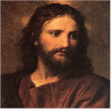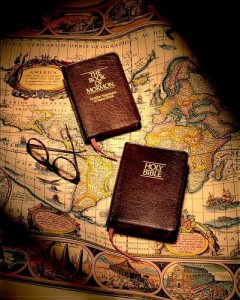|
||
Mormon ScripturesThe standard Mormon books of scripture currently include: The Holy Bible, King James Version
The King James version is considered by Mormons to be the most accurate English translation of the Bible. Mormonism teaches that the Bible went through countless alterations during the first two centuries of its existence; however, so far as it has been translated correctly, the Bible contains the word of God. Each member of the Mormon Church is instructed to study the Old and New Testaments and pray to know of their truthfulness. The word Bible is a Greek derivation, meaning “the books,” so the Bible can be considered a library of writings that contain records of divine revelation. The Old Testament is the record that was used by the Jews of Palestine in the first century A.D. The New Testament contains writings of the time during which Jesus Christ and His apostles were on the earth. The books of the Old Testament were written mostly in Hebrew, and the books of the New Testament, in Greek. The word testament is a translation of a Greek word meaning “covenant.” Thus, the Old Testament, or Old Covenant, is the record of the original law given by the Lord to the prophet Moses. The New Testament records the new covenant brought to the Lord’s people when Jesus Christ came to earth. The second of the Mormon books of scripture is the Book of Mormon itself, subtitled “Another Testament of Jesus Christ,” as it joins the Bible in affirming the divine mission of Jesus as the Savior of the entire world. Whereas the Bible was written in Palestine, the Book of Mormon was written on the American continent. It contains the divine revelations that were received by a few separate nations living in antiquity. The primary record in the volume begins around 600 B.C. when a prophet named Lehi was called to leave his homeland of Jerusalem and travel across the ocean to America. His progeny established a nation whose faithfulness to the Lord continually fluctuated, much like that of any other of God’s children on earth. Although the people were eventually honored with a glorious visit from the resurrected Christ, wickedness gradually returned to their hearts and dealt a fatal blow to countless thousands. (The surviving peoples became the ancestors of at least some of the American Indian tribes present today.) The records of the prophets and more righteous generations were abridged by a heaven-inspired man named Mormon and protectively buried in the earth by his son Moroni around A.D. 400. The prophet Joseph Smith received the divine commission to obtain this sacred record, containing the fullness of Christ’s gospel in purity, and translate it into modern English. The Book of Mormon represents, therefore, the crux of all Mormon books, Mormon theology, and the Mormon Church. If the Book of Mormon is true, then Joseph Smith was a true prophet, which means that the Church he established is the true Church of God and Christ. The fervently sincere invitation of The Church of Jesus Christ of Latter-day Saints and all its “Mormon missionaries” is encapsulated in the words of Moroni: Behold, I would exhort you that when ye shall read these things, if it be wisdom in God that ye should read them, that ye would remember how merciful the Lord hath been unto the children of men, from the creation of Adam even down until the time that ye shall receive these things, and ponder it in your hearts. And when ye shall receive these things, I would exhort you that ye would ask God, the Eternal Father, in the name of Christ, if these things are not true; and if ye shall ask with a sincere heart, with real intent, having faith in Christ, he will manifest the truth of it unto you, by the power of the Holy Ghost (Moroni 10:3-4). The Prophet Joseph Smith not only translated the Book of Mormon, but he also compiled other revelations that he received from the Lord. Many of these revelations are found in the Doctrine and Covenants. This work’s main purpose is to instruct Mormon Church members and leaders about how the Church should be organized and directed in order to be in harmony with Christ’s kingdom. It also contains many revelations about important doctrines. Most (133) of the revelations were received by the Prophet Joseph Smith. The seven remaining sections, including two declarations, were received by other leaders of the Mormon Church. Many of the passages have a specific historical setting and were received in answer to specific prayers. The revelations have a universal application, however, making them still relevant today. As described in its “Introductory Note,” The Pearl of Great Price is a “selection of choice materials” relative to aspects of faith and doctrine of the Mormon Church. Much of this material was received by Joseph Smith through revelation and translation. Its present contents include the following: The Book of Moses, or Selections from the Book of Moses, consists of several revelations given to Joseph Smith while he was revising the Bible under inspiration, beginning in June 1830. The Book of Abraham contains writings of Abraham and is a translation from some Egyptian papyri that the Mormon Church obtained in 1835. It includes a record of the life of the patriarch Abraham and also a description of the creation of the world that is similar to that recorded in Genesis and the Book of Moses. Joseph Smith—Matthew is an extract from the testimony of Matthew taken from Joseph Smith’s translation of the Bible. Mormons revere the scriptures and use them daily for personal study, family study, and church services. They believe that daily scripture study truly brings personal revelation and increases the companionship of the Lord’s Spirit. When a person studies the scriptures and prays to receive a personal testimony of the truth of the word of God, he or she will have increased power to obey God’s commandments and serve faithfully in His Church.
|


